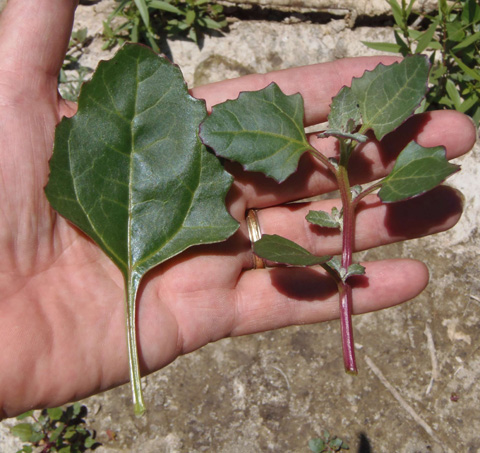Description
Chenopodium macrospermum var. farinosum was reported from ore piles adjacent to Baltimore Harbor (Reed 1964).
Taxonomy
| Kingdom | Phylum | Class | Order | Family | Genus |
|---|---|---|---|---|---|
| Plantae | Magnoliophyta | Magnoliopsida | Caryophyllales | Chenopodiaceae | Chenopodium |
Synonyms
Invasion History
Chesapeake Bay Status
| First Record | Population | Range | Introduction | Residency | Source Region | Native Region | Vectors |
|---|---|---|---|---|---|---|---|
| 1955 | Extinct | Contracting | Introduced | Regular Resident | South America | South America | Shipping(unspecified) |
History of Spread
Chenopodium macrospermum (Largeseed Goosefoot) is native to South and Central America, north to Mexico (Cohen and Carlton 1995; Reed 1964). It is established and widespread on the coast of CA, where it was first collected in 1862 in Marin County (CalFlora 2001). On the East Coast, C. macrospermum was collected on ballast in Wilmington NC (date unknown), and on ore piles in Baltimore Harbor, Chesapeake Bay, in 1953-55 (Reed 1964). This plant is apparently not established in Chesapeake Bay or the East Coast, and is not included in local or regional floras.
References- CalFlora 2001; Cohen and Carlton 1995; Reed 1964
Invasion Comments
Ecology
Environmental Tolerances
| For Survival | For Reproduction | |||
|---|---|---|---|---|
| Minimum | Maximum | Minimum | Maximum | |
| Temperature (ºC) | ||||
| Salinity (‰) | 0.0 | 0.0 | ||
| Oxygen | ||||
| pH | ||||
| Salinity Range | fresh-meso |
Age and Growth
| Male | Female | |
|---|---|---|
| Minimum Adult Size (mm) | ||
| Typical Adult Size (mm) | ||
| Maximum Adult Size (mm) | ||
| Maximum Longevity (yrs) | ||
| Typical Longevity (yrs |
Reproduction
| Start | Peak | End | |
|---|---|---|---|
| Reproductive Season | |||
| Typical Number of Young Per Reproductive Event |
|||
| Sexuality Mode(s) | |||
| Mode(s) of Asexual Reproduction |
|||
| Fertilization Type(s) | |||
| More than One Reproduction Event per Year |
|||
| Reproductive Startegy | |||
| Egg/Seed Form |
Impacts
Economic Impacts in Chesapeake Bay
Chenopodium macrospermum (Large-seed Goosefoot) appears to be extinct in the Chesapeake Bay region, and has no reported economic impacts.
Economic Impacts Outside of Chesapeake Bay
Chenopodium macrospermum (Large-seed Goosefoot) has no reported economic impacts in its introduced range.
Ecological Impacts on Chesapeake Native Species
Chenopodium macrospermum (Large-seed Goosefoot) appears to be extinct in the Chesapeake Bay region, and has no reported impacts on native biota.
Ecological Impacts on Other Chesapeake Non-Native Species
Chenopodium macrospermum (Large-seed Goosefoot) appears to be extinct in the Chesapeake Bay region, and has no reported impacts on exotic biota.
References
2023-204 The Calflora Database. http://dlp.cs.berkeley.edu/calflora/Cohen, Andrew N.; Carlton, James T. (1995) Nonindigenous aquatic species in a United States estuary: a case study of the biological invasions of the San Francisco Bay and Delta, , Washington DC, Silver Spring MD.. Pp.
1997-2024 USDA PLANTS Database.. Onine databse
Reed, Clyde F. (1964) A flora of the chrome and manganese ore piles at Canton, in the port of Baltimore, Maryland and at Newport News, Virginia, with descriptions of genera and species new to the flora of the eastern United States., Phytologia 10: 321-406
